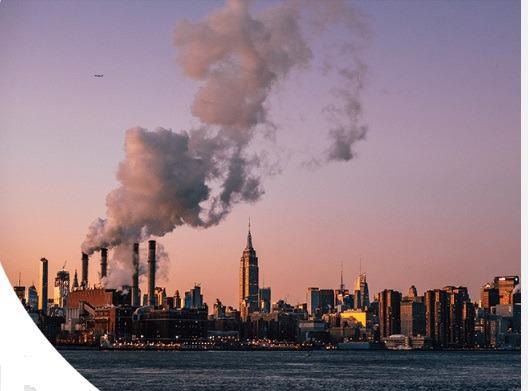Photochemical and sulfurous smog vary due to the respective composition of each and the weather conditions that give rise to them. Photochemical smog usually appears in hot and sunny conditions and hits at the peak of the afternoon.

Image Credit: Ion Science
Sulfurous smog is usually much worse in cold and damp atmospheres and typically peaks around dawn. Pollution can be swept by the wind into a city, mostly from smoke as a result of vegetation burning and from emissions released by a power station.
Clean Air
The planet has a dynamic atmosphere: various biological, physical and chemical processes combine to produce ‘clean air,’ a mix of gas that is outstandingly well-balanced for life and free of toxic gases and particulates.
Besides halocarbons and a few inert gases, the concentration of gases in the atmosphere tends to be in constant flux and is vigorously mediated by living processes. Additionally, the concentration is typically at the optimal levels required for life.
Oxygen is proportionate at a concentration that allows aerobic organisms such as humans and other mammals to breath easily, whilst not too high as to result in inextinguishable forest fires.
Carbon dioxide is abundant enough for plants to thrive, both as a source of carbon and in maintaining sufficient but not excessive warmth from the sun. Elements crucial for life, including sulfur and iodine, are transferred from land to sea in the form of volatile organic compounds (VOCs).
Numerous gases, which are considered toxic or harmful to life, are extracted by chemical and physical adsorption on solid particles (particulates), which are eventually pushed out of the air under gravity as dust or rain.
Furthermore, via a series of complex chemical reactions, including photochemical reactions (reactions with sunlight), the atmosphere remains almost free entirely of specific VOCs released by plants, seemingly to their own and greater benefits.
For instance, recently, it has been determined that when bruised, plant leaves emit VOC messengers (pheromones) that lure in the predators of leaf-eating insects.

Image Credit: Ion Science
Human Impact on Air Quality
Gases and particulates that are a result of human-based activity are faced with exactly the same processes as those realized naturally: being either photochemically oxidized and/or in producing and condensing on particulates which eventually fall out as dust or rain.
However, the pure amount of particular ‘primary pollutants’ released by way of human activity can be a danger, as well as in producing ‘secondary pollutants’ through a series of different reactions.
Also, greater concentrations of VOCs, for instance, when discharged into the air, can ‘overwhelm’ the extremely low concentrations of atmospheric cleansing agents in air, which are highly reactive, such as OH and NO3. This means that they remain unchanged for longer than they would be in cleaner air.
Primary pollutants, directly released into the atmosphere, include:
- NO and NO2 (‘NOx’), mostly from coal-fired power stations and vehicle exhaust fumes
- SO2 and SO3 (‘SOx’) mostly from power stations and sulfurous coal-burning stoves
- CO from coal burning, wood burning and vehicle exhaust emissions.
VOCs, with the exception of methane, typically come from the following sources:
- Unburnt hydrocarbons from vehicles. This pollutant can be eliminated where legislation assures catalytic conversion of unburnt hydrocarbons
- Solvent release and spills. These may be a result of uncontrolled industrial plant processes, spillages and fugitive emissions but may also be a feature of urban pollution as a result of the volatilization of solvents in certain domestic products such as cleaners and polishes.
- Terpenes released from forest fires.
Secondary pollutants resulting from the action of sunlight on NOx and VOCs are:
- Ozone, O3, is extremely hazardous to all lifeforms in the lower atmosphere
- Aldehydes, such as formaldehyde, a hazardous biocide
- Peroxyacyl nitrates (PANs)
- A resultant photochemical or ‘Los Angeles’ smog made up of particulates typically comprised of metal oxides, nitric acid, PAN, dissolved VOCs and SVOCs
- Sulfurous or ‘London’ smog, which is a result of sulfurous coal burning, is made up of water, ash, PAHs, sulfuric acid and nitric acid
- Acid rain is a secondary pollutant that is produced when a reaction occurs in rain droplets between NOx and SOx

 Download the full air quality monitoring guide here
Download the full air quality monitoring guide here

Image Credit: Ion Science

This information has been sourced, reviewed and adapted from materials provided by Ion Science.
For more information on this source, please visit Ion Science.